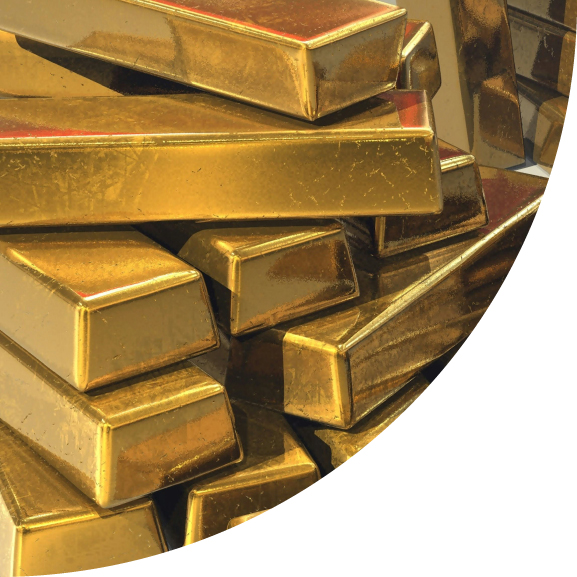Monthly Investment Note - Gold Investing

Is gold a viable investment solution within a diversified portfolio?
This month, we look at whether gold has a place in a multi-asset portfolio after a very strong run-up in price and the evolving economic landscape. The question remains, should the precious metal form part of a long-term portfolio?
What has happened?
After the gold price rose to record highs in the first quarter of 2024, prices have continued to move north making numerous new highs and peaking in October with the yellow metal touching USD$2.790 per troy ounce. A rally which yielded a return, at that point in time, of approximately 35%, calendar-year-to-date.
Why has the gold price rallied so hard so fast?
Gold has historically been a ‘safe haven’ for investors, a level of protection for rising or high levels of inflation and/or heightened levels of geopolitical risk. Sovereign governments & central banks have also traditionally purchased gold due to the metals’ ability to be used in the event of a crisis to the international financial system.
Over the past two years, the environment has been the perfect storm for the gold price. Conflicts and rising geopolitical tensions, high inflation, and concerns regarding the devaluation of physical currency (via money printing), amongst other things, have all helped propel the price of gold to the levels seen today.
What is also of interest is that China’s central bank has also been tapping further into its foreign currency reserves to buy gold, whereas in the past it used yuan,the local currency. In short, it has been swapping its US dollar reserves - which have decreased considerably - for gold in what could be construed as part of Beijing's mission to move away from using the US Dollar for trade. China isn’t alone on this front.
In recent times, the level of national debt and the printing of money has brought into question the value of paper money (referred to as ‘fiat’ currency) over the long term. Gold remains a finite source and therefore has the ability to better retain its relative value over and above paper currency. These factors help explain partially, why the price of gold has risen to these historical levels.

The disconnect between the gold price and the price of gold miners
Should I hold physical gold (usually via an ETF) or get my exposure via gold mining companies?
This is a common question many investors ask and in recent times, the former has won out whilst gold miners have lagged.
The disconnect between the gold price and the value of gold miners (their equity) could simply be put down to costs of production, but there are several reasons which have been floated. Although the miners still possess reasonable margins, these margins have suffered in recent times due to rising financing and operating costs. These include higher debt servicing costs, rising labour & machinery costs, and delays to production due to weather events / safety / Covid / staff shortages. These have meant that gold miners haven’t been able to capitalise fully on the surge in demand for gold and subsequent gold price surge. Other factors such as poor capital discipline on M&A front and reduced mine life have also contributed to poor relative returns.
Will the spread between the two narrow? Narrowing in the spread can come from gold miner share prices rising or from physical gold prices falling. It has started to narrow over the last six to nine months but remains quite wide versus history. The disconnect however is not a new phenomenon, but the level and duration is quite unique. Buying gold miners solely on the expectation that the gap closes has been fraught with danger and involves plenty of timing risk. Not something we would advocate.
If the gold miners can contain costs, continue to provide high levels of free cash flow, and maintain good capital discipline, they should offer greater leverage to gold price moves than an investment in the physical, thus, potentially making significant inroads to the discount.
Where now for the gold price?
As noted, the gold price historically has been driven by a number of factors not withstanding standard supply and demand dynamics. The direction of gold over this coming cycle however could be very challenging. There is no simple answer to explain the direction given how many drivers there are of the gold price and varied reasons for investor buying / selling. The inability to accurately value gold remains the biggest criticism against it.
Real yields and their relationship with the gold price has been a key driver in the past. That is, the gold price and real yields – the nominal bond yield minus inflation - have historically been tightly inversely correlated. When one falls, the other tends to rise. This relationship has been quite visible since the turn of the century however this has changed over the last eighteen months(see chart below). Real yields have been trending downwards whilst the price of gold continues to rise (for some of the reasons outlined above). This is just one challenging aspect in trying to determine the direction of gold.
There are several tailwinds and headwinds for the price of gold in the immediate future which introduces more challenges. Rate cuts in the U.S. could see the precious metal rally into 2025 (though some of this might already be in the price). However, the recent narrative from the U.S. Federal Reserve Governor indicates that they will not be pressured into rate cuts should inflation remain sticky. Strong upward momentum could continue if sovereigns maintain their pace of buying, particularly if conflicts escalate and geopolitical tensions rise. Continued support could also come from governments continuing to run up large fiscal deficits and/or a significant uplift in central bank money printing, particularly if that results in a re-acceleration inflation and further currency devaluing.
What are the headwinds? What could be the tipping point for a lower gold price?
Whilst you could argue that the price of gold defies traditional valuation attempts as well as its relationship to other asset classes, the risks of a correction cannot be ignored. A de-escalation of global geopolitical conflicts, sharp falls in inflation under a hard or harder landing economic scenario, continued relative strength in the U.S dollar against major world currencies, a rapid rally in US Treasury bond yields, and a sharp decline in demand for the precious metal in China could all cause the gold price to fall.
Statistics from the World Gold Council has already indicated gold consumption in China has been falling sharply with demand dropping 22%. Interestingly, the People's Bank of China has not purchased the precious metal for five consecutive months. Finally,the recent victory by Donald Trump in the U.S. election, and likely policies to come, could also have a reasonable impact on the gold price going forward.

Is gold a valid portfolio inclusion?
It is important to be fully informed and somewhat more critical when considering any new portfolio inclusion, particularly after such a strong run. Asset allocation and portfolio diversification continue to remain key elements in any investment decision to enable investors to reach their financial goals.
As mentioned, the use of gold within a portfolio can have both positive and negative impacts depending on the environment and where we are in the economic cycle. The key benefit continues to be portfolio diversification. Having a mix of investments blended in a well-balanced portfolio will provide a smoother ride over the long-term and gold can certainly assist in this light. However, the negatives are also clear given the inability to accurately value the asset, no ongoing income or dividend stream, and the potential drag on portfolio performance in strongly rising markets.
Conclusion
The main reason to consider the use of gold in portfolios is to protect against the risks of rising or stubbornly high inflation and provide additional diversification. The decision remains a rather personal or individual one.
There are various ways to get exposure to gold in a portfolio including the physical(usually via a gold-backed ETF) or gold mining companies. The physical is usually more optimal, but gold mining companies can provide additional upside,particularly if the price gap closes.
However,the main sticking points for not using physical gold in portfolios remains – no income generation, short-term volatility and price fluctuations, no cash flows or earnings growth makes it hard to accurately value, and the opportunity cost of investing elsewhere.
As always, speak to your adviser before making any investment decisions.
Latest insights
You might also like












